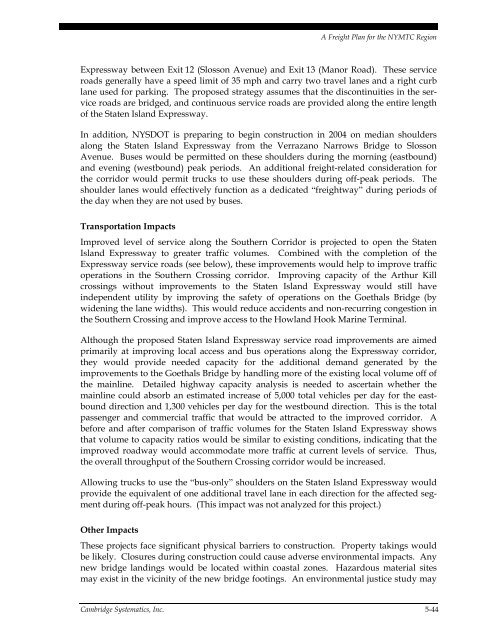nymtc regional freight plan - New York Metropolitan Transportation ...
nymtc regional freight plan - New York Metropolitan Transportation ...
nymtc regional freight plan - New York Metropolitan Transportation ...
Create successful ePaper yourself
Turn your PDF publications into a flip-book with our unique Google optimized e-Paper software.
A Freight Plan for the NYMTC Region<br />
Expressway between Exit 12 (Slosson Avenue) and Exit 13 (Manor Road). These service<br />
roads generally have a speed limit of 35 mph and carry two travel lanes and a right curb<br />
lane used for parking. The proposed strategy assumes that the discontinuities in the service<br />
roads are bridged, and continuous service roads are provided along the entire length<br />
of the Staten Island Expressway.<br />
In addition, NYSDOT is preparing to begin construction in 2004 on median shoulders<br />
along the Staten Island Expressway from the Verrazano Narrows Bridge to Slosson<br />
Avenue. Buses would be permitted on these shoulders during the morning (eastbound)<br />
and evening (westbound) peak periods. An additional <strong>freight</strong>-related consideration for<br />
the corridor would permit trucks to use these shoulders during off-peak periods. The<br />
shoulder lanes would effectively function as a dedicated “<strong>freight</strong>way” during periods of<br />
the day when they are not used by buses.<br />
<strong>Transportation</strong> Impacts<br />
Improved level of service along the Southern Corridor is projected to open the Staten<br />
Island Expressway to greater traffic volumes. Combined with the completion of the<br />
Expressway service roads (see below), these improvements would help to improve traffic<br />
operations in the Southern Crossing corridor. Improving capacity of the Arthur Kill<br />
crossings without improvements to the Staten Island Expressway would still have<br />
independent utility by improving the safety of operations on the Goethals Bridge (by<br />
widening the lane widths). This would reduce accidents and non-recurring congestion in<br />
the Southern Crossing and improve access to the Howland Hook Marine Terminal.<br />
Although the proposed Staten Island Expressway service road improvements are aimed<br />
primarily at improving local access and bus operations along the Expressway corridor,<br />
they would provide needed capacity for the additional demand generated by the<br />
improvements to the Goethals Bridge by handling more of the existing local volume off of<br />
the mainline. Detailed highway capacity analysis is needed to ascertain whether the<br />
mainline could absorb an estimated increase of 5,000 total vehicles per day for the eastbound<br />
direction and 1,300 vehicles per day for the westbound direction. This is the total<br />
passenger and commercial traffic that would be attracted to the improved corridor. A<br />
before and after comparison of traffic volumes for the Staten Island Expressway shows<br />
that volume to capacity ratios would be similar to existing conditions, indicating that the<br />
improved roadway would accommodate more traffic at current levels of service. Thus,<br />
the overall throughput of the Southern Crossing corridor would be increased.<br />
Allowing trucks to use the “bus-only” shoulders on the Staten Island Expressway would<br />
provide the equivalent of one additional travel lane in each direction for the affected segment<br />
during off-peak hours. (This impact was not analyzed for this project.)<br />
Other Impacts<br />
These projects face significant physical barriers to construction. Property takings would<br />
be likely. Closures during construction could cause adverse environmental impacts. Any<br />
new bridge landings would be located within coastal zones. Hazardous material sites<br />
may exist in the vicinity of the new bridge footings. An environmental justice study may<br />
Cambridge Systematics, Inc. 5-44
















